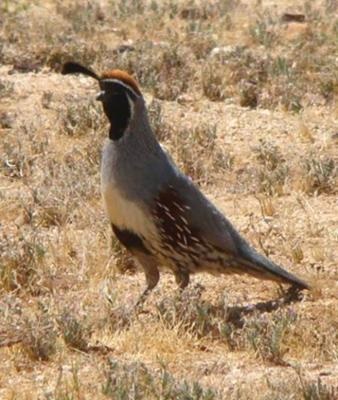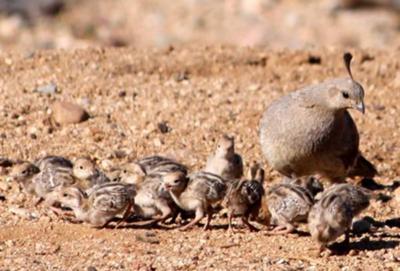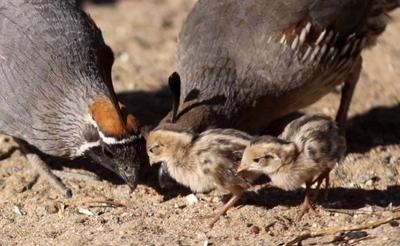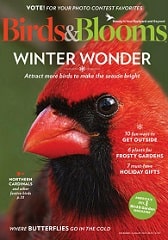Discovering Gambel's Quail: Mating, Nesting, and Feeding Habits
Gambel's quails are small, plump ground-dwelling birds that are native to the southwestern United States and parts of Mexico.
They are named after William Gambel, an American naturalist who collected specimens of the species during an expedition to the American West in the mid-19th century.

Male Gambel's Quail
Gambel's quails are known for their distinctive appearance, with males having a prominent black plume on their heads and females having a more subtle brown and white coloration.
Mating Habits
Gambel's quails are monogamous birds, meaning that they form pair bonds with a single mate for the duration of the breeding season.
The breeding season typically lasts from March to June, with mating occurring in the early spring. During this time, males engage in courtship displays to attract females.
These displays include a variety of behaviors, such as puffing up their feathers, bobbing their heads, and emitting a distinctive call.
The males may also engage in "tidbitting," where the male offers foraged food to the female.
Once a female has chosen a mate, the pair will remain together for the duration of the breeding season.
They will engage in preening behavior to reinforce their bond and may engage in duets, where they call back and forth to each other.
The female will then begin to prepare a nest for the eggs, while the male will defend their territory and provide food for both himself and his mate.
Nesting Habits
Gambel's quails build their nests on the ground, typically in dense brush or vegetation.
The nest is a shallow depression lined with grasses and other plant material and is often hidden from view to protect it from predators.
| Gambel's Quail Nesting Stats | |
|---|---|
| Eggs | 10 - 14 |
| Incubation | 21 days |
| Nestling Phase | Follow Adults after Hatching |
| Broods | 1 most common / sometimes 2 |
Females typically lay between 10 and 14 eggs, which are incubated for approximately 21 days.
During this time, both the male and female will take turns incubating the eggs and protecting the nest from predators.
After the eggs hatch, the chicks begin following the adults, who will continue to brood the chicks.
The chick will gather under the fluffed-out feathers of the adults to keep warm, as they cannot regulate their body temperature.
Brooding the chicks will last for several days. It will take 2 1/2 to 3 months for the chicks to become independent.
Feeding Habits
Gambel's quails are omnivorous birds, meaning that they eat a variety of plant and animal matter.
Their diet consists primarily of seeds, fruits, and insects, but they will also consume small lizards and rodents when available.
They are ground feeders, using their strong legs and feet to scratch through leaf litter and other debris in search of food.
They may also eat the seeds of cacti and other desert plants, which are an important source of moisture in their arid habitat.
During the breeding season, females will also consume calcium-rich foods to help with the production of eggshells. This may include snails, which are a good source of calcium carbonate.
Males will also consume calcium-rich foods to maintain their strength and energy during the breeding season.
Winter Habits
During the winter months, Gambel's quails adapt their behavior and habits to survive in their arid habitat.
They may face challenges such as colder temperatures, shorter days, and reduced availability of food and water sources.
To conserve energy and stay warm during the colder months, Gambel's quails will often roost in groups.

Quail Chicks Feeding
This helps to reduce heat loss and protect them from predators. They may also fluff up their feathers to create an insulating layer of air around their bodies.
Food sources may also be less abundant during the winter months, particularly in areas where vegetation has died back due to the colder temperatures.
To compensate for this, Gambel's quails may switch to a diet of mostly seeds and other plant matter.
They will also take advantage of any available food sources, such as fruits or insects, that are still present in their habitat.
Water can also be a challenge during the winter months, as water sources may be frozen or dry up entirely.
Gambel's quails can survive for extended periods without drinking water, but they still require moisture in their diet.
To meet this need, they may obtain moisture from succulent plant parts or dew that forms on vegetation in the early morning.
During the winter months, Gambel's quails may also alter their social behavior.
They may form larger flocks than they do during the breeding season, which helps to protect against predators and increases their chances of finding food and water sources.
Flocks may consist of multiple family groups or unrelated individuals.
Conservation efforts aimed at protecting their habitat and ensuring the availability of food and water sources may be important for the long-term survival of these birds during the winter months.
Predators
Gambel's quails are preyed upon by a variety of predators throughout their range.
The eggs and nestlings are particularly vulnerable to predation, as they are often left unattended by the adult birds while they forage for food or defend their territory.
Some of the most common predators of Gambel's quail eggs and nestlings include snakes, rodents, and ground-dwelling birds, such as roadrunners.
In addition to these predators, Gambel's quails are also hunted by a variety of larger animals.
Coyotes, foxes, and bobcats are all known to prey upon adult Gambel's quails, particularly during the breeding season, when they are more vulnerable due to their territorial behavior.

Family of Gambel's Quail
Raptors such as hawks and owls are also a threat to adult birds, particularly during the non-breeding season, when Gambel's quails may form larger flocks that make them easier targets.
To protect themselves and their young from predators, Gambel's quails use a variety of strategies.
The female will use camouflage to conceal the nest, and will often stay near the nest to protect the eggs and chicks.
If a predator approaches, the female may use distraction displays or feign injury to draw the predator away from the nest or chicks.
Male Gambel's quails will often use their calls and physical displays to deter predators from entering their territory.
Despite these strategies, predation is a significant threat to Gambel's quail populations.
Habitat loss may also increase the vulnerability of these birds and other ground-dwelling birds in the southwestern United States.



